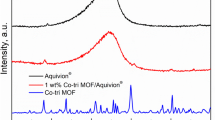Abstract
Perfluorosulfonic acid/ceramic nanocomposite membranes were investigated as electrolytes for polymer electrolyte membrane fuel cell applications under low relative humidity. Different nanosized ceramics (SiO2, ZrO2, TiO2) with diameters in the range of 2-6 nm were synthesized in situ in Nafion solution through a sol-gel process and the formed nanosized ceramics were well-dispersed in the solution. The nanocomposite membranes were formed through a casting process. The nanocomposite membrane showes enhanced water retention ability and improved proton conductivity compared to those of pure Nafion membrane. The mechanical strength of the formed nanocomposite membranes is slightly less than that of pure Nafion membrane. The experimental results demonstrate that the polymer ceramic nanocompsite membranes are potential electrolyte for fuel cells operating at elevated temperature.
Similar content being viewed by others
References
Alberti G, Casciola M, Composite Membranes for Medium-Temperature PEM Fuel Cells [J]. Annu. Rev. Mater. Res., 2003, 33:129–154
Zhang JL, Xie Z, Zhang JJ, et al. High Temperature PEM Fuel Cells [J]. J. Power Sources, 2006, 160: 872–891
Li QF, He RH, Gao J, et al. The CO Poisoning Effect in Polymer Electrolyte Membrane Fuel Cells Operational at Temperatures up to 200°C [J]. J. Electrochem. Soc., 2003, 150: A1599–1605
Vishnyakov V M, Proton Exchange Membrane Fuel Cells[J]. Vacuum, 2006, 80:1053–1065
Devanathan R, Recent Developments in Proton Exchange Membranes for Fuel Cells[J]. Energy Environ. Sci., 2008, 1: 101–109
Sacca A, Gatto I, Carbone A, et al. ZrO2-Nafion Composite Membranes for Polymer Electrolyte Fuel Cells (PEFCs) at Intermediate Temperature [J]. J. Power Sources, 2006, 163: 47–51
Chen SY, Han CC, Tsai CH, et al. Effect of Morpholo- gical Properties of Ionic Liquid-Templated Mesoporous Anatase TiO2 on Performance of PEMFC With Nafion/TiO2 Composite Membrane at Elevated Temperature and Low Relative Humidity [J]. J. Power Sources, 2007, 171: 363–372
Mauritz KA, Payne JT, Perfluorosulfonate Ionomer/Silicate Hybrid Membranes via Base-Catalyzed in situ Sol-Gel Processes for Tetraethylorthosilicate[J]. J. Membr. Sci., 2000, 168: 39–51
Alberti G, Casciola M, Solid State Protonic Conductors Present Main Applications and Future Prospects [J]. Solid State Ionics, 2001, 145: 3–16
Adjemian KT, Dominey R, Krishnan L, et al. Function and Characterization of Metal Oxide Nafion Composite Membranes for Elevated Temperature H2/O2 PEM Fuel Cells [J]. Chem. Mater., 2006, 18: 2238–2248
Jalani NH, Dunn K, Datta R, Synthesis and Characterization of Nafion-MO2 (M=Zr, Si, Ti) Nanocom-Posite Membranes for Higher Temperature PEM Fuel Cells [J]. Electrochim Acta, 2005, 51:553–560
Apchatachutapan W, Moore RB, Mauritz KA, Asymmetric Nafion/Zirconium Oxide Hybrid Mem- branes via in situ Sol-Gel Chemistry [J]. J. Appl. Polym. Sci., 1996, 62:417–426
Tang HL, Wan ZH, Pan M, et al. Self-assembled Nafion-Silica Nanoparticles for Elevated-High Temper- ature Polymer Electrolyte Membrane Fuel Cells [J]. Electrochem. Commun, 2007, 9: 2003–2008
Pereira F, Valle K, Belleville P, et al. Advanced Mesostructured Hybrid Silica-Nafion Membranes for High-Performance PEM Fuel Cell [J]. Chem. Mater., 2008, 20: 1710–1718
Zhang HL, Pan JJ, He XC, et al. Zeta Potential of Nafion Molecules in Isopropanol-Water Mixture Solvent [J]. J. Appl. Polym. Sci., 2008, 107: 3306–3309
Pan JJ, Zhang HL, Pan M, Self-assembly of Nafion Molecules onto Silica Nanoparticles Formed in situ through Sol-Gel Process [J]. J. Coll. Interf. Sci., 2008, 326(1): 55–60
Li K, Ye GB, Pan JJ, et al. Self-Assembled Nafion/Metal Oxide Nanoparticles Hybrid Proton Exchange Membranes[J]. J. Membr. Sci., 2010, 347: 26–31
Author information
Authors and Affiliations
Corresponding author
Additional information
Funded by the Postdoctoral Science Foundation of China (2013M540610) and the Hubei Province Scientific Research Projects (D20131601)
Rights and permissions
About this article
Cite this article
Li, Q., Wang, G., Ye, H. et al. Nanocomposite membranes based on perfluorosulfonic acid/ceramic for proton exchange membrane fuel cells. J. Wuhan Univ. Technol.-Mat. Sci. Edit. 30, 1125–1129 (2015). https://doi.org/10.1007/s11595-015-1282-7
Received:
Accepted:
Published:
Issue Date:
DOI: https://doi.org/10.1007/s11595-015-1282-7




